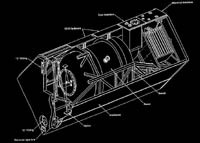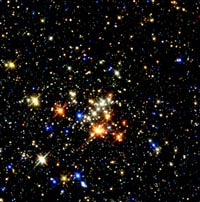Advanced Camera for Surveys
One of the Hubble Space Telescope's advanced instruments is referred to as the ACS.
HubbleÕs newest science instrumentÑthe Advanced Camera for Surveys Ñbrought the telescope into the 21st century. With its wider field of view, sharper image quality, and enhanced sensitivity, the new camera doubles HubbleÕs field of view and expands its capabilities significantly. Upgrading the telescope with ACSÕs cutting-edge technology made it ten times more effective and prolonged its useful life.
ACS is actually a team of three different cameras: the wide field camera, the high-resolution camera, and the solar blind camera. It outperforms all previous instruments flown aboard the Hubble Space Telescope, primarily because of its expanded wavelength range. Designed to study some of the earliest activity in the universe, ACS sees in wavelengths ranging from far ultraviolet to infrared.
ACS maps the distribution of dark matter, detects the most distant objects in the universe, searches for massive planets, and studies the evolution of clusters of galaxies. To accommodate these science goals, each of ACS's three cameras was designed to perform a specific function.
With a field of view twice that of WFPC2, ACS's wide field camera conducts broad surveys of the universe. Astronomers use it to study the nature and distribution of galaxies, which reveal clues about how our universe evolved.
The high-resolution camera takes extremely detailed pictures of the inner regions of galaxies. It searches neighboring stars for planets and planets-to be, and takes close-up images of the planets in our own solar system.
The solar blind camera, which blocks visible light to enhance ultraviolet sensitivity, focuses on hot stars radiating in ultraviolet wavelengths.
ACS was installed during Servicing Mission 3B in March 2002. The new instrument was built between 1996 and 1999 by scientists and engineers at The Johns Hopkins University, Ball Aerospace, the Space Telescope Science Institute, and NASAÕs Goddard Space Flight Center.(Text adapted from NASA description.)
|
Índice |

